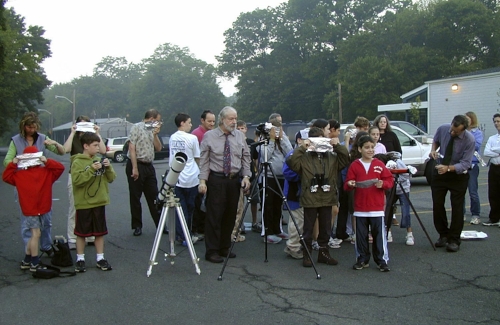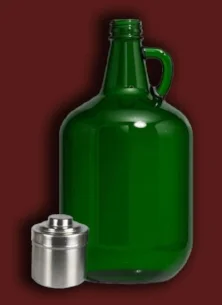In 1997, I began to make plans for the 1999 eclipse—the last Total Solar Eclipse of the Twentieth Century. Because I had already led a photographic safari in Kenya in the early 90s, I thought I might do the same thing with an eclipse trip. The idea was that I would teach seminars about eclipses and astro-photography to a group of about ten people and then we'd go on a ship that sailed the Black Sea near Turkey (the place that seemed to have the best summer prospects for clear skies along the eclipse path). I prepared a brochure for the group, put it on the net and then sent it out to friends, family, and photography clients.
I made the above picture for that brochure. The building is the Sultan Ahmed Mosque or Blue Mosque in Istanbul. I thought that it was fittingly picturesque, and, because it was in Turkey, it was also appropriate, although, technically, it was not in the path of totality. I got the picture of the mosque from the Internet; the super-imposed picture of the eclipsed sun was one I had taken of the 1991 eclipse in Mexico.
I had a number of nibbles for the trip and some real interest, although few firm commitments, but I was determined to go anyway.
The cruise was excellent in every way except one: the shipboard preparations for the eclipse. Apparently very few people, including the guests, the crew and staff, knew or cared much about solar eclipses. It was a cruise, the final voyage of a venerable ocean liner, The Norwegian America Vistafjord, last cruse ship of the The Norwegian America Line. Out of the 600 or so passengers, only twenty were fellow astronomy-buffs. The rest were there for the pleasures of luxury and visits to the various ports of call: Troy, Istanbul, Yalta, Odessa, and Venice. Surely, more than enough attractions for anyone, without a solar eclipse.
The ship had hired two scientists to give lectures, but they were sparsely attended. Only the fine astro-artist, Jon Lomberg, seemed to connect with the passengers, and he evinced real enthusiasm throughout the entire cruise.
The day of the eclipse arrived clear and bright, and I went out on the main aft deck. The eclipse would take place at around 1 pm, so I got there with my stuff just before noon. And what was going on? Were the scientists on deck with their scopes giving talks? Was there a buzz of excitement? No, there was a fashion show. A Pilipino rock band played out. Preparations were being made for the regular Wednesday bar-b-q. Colorful clothes for sale were spread out on a vast array of tables. Hardly an atmosphere conducive to the awesome astronomical event that was to come.
I talked to Gesa, the friendly cruise-director, and I asked her if she could get things toned down a bit. I assured her that what she and all aboard were about to see might prove to be a terrific experience. She agreed and succeeded in curtailing most of the events. Smartly, the ship had bought mylar and cardboard eclipse viewers, and they were passed out to everyone. By about 12:30, most people had eaten lunch, the band had quit playing, and folks were settling into their desserts and third beers with growing anticipation.
Then the sunlight began to dim. And dim. Inexorably, the shadow of the moon, unseen to us, was approaching the ship from the west.
The eclipse was beautiful. For two and a half minutes, everyone was focused on a small black circle with a white shimmering fringe high up above. The sky was a deep, dark blue and the horizon, all the way around, glowed pink. Mercury and Venus could be seen. People— passengers, crew and staff, alike—were excited and awestruck upon the calm Black Sea.
After it was over, and when broad daylight had returned, I asked Gesa if the ship would be offering any mementos of the stunning occurrence we had all just been part of. A T-shirt, perhaps? She said, sadly, that the company had not thought of anything like that. She agreed that it would be a great idea, she even wanted something of the kind for herself, but she saw no way of providing any such service. She said I was free to do whatever I wanted, but the ship would not be involved.
Thanks, but what could I do? Then I remembered the trip brochure I had made a few years before. It was still up on the net along with that picture of the mosque and the eclipse. I figured that if I could somehow get that picture and print it out, I could show it to people on board and offer a T-shirt of the mosque with an image of our eclipse on the front and this on the back:
The Last
Total Solar Eclipse
of the 20th Century
August 11, 1999
The Black Sea
Unfortunately, the ship was not properly set up to receive or print pictures from the Internet. But, when we got to Istanbul, our first port of call after the eclipse, I set out to find a place that had Internet access and a printer. Heck, I wanted a T-shirt! So I went ashore and wandered around looking for a high-tech place in the ancient city. And, wouldn't you know it: I found a little Internet cafe that was a block away from, and literally in the shadow of, the Blue Mosque.
The shop was run by an Australian expatriate. He had everything I needed, and, for one dollar, he got on the net, went to my site, found the brochure, and printed out a nice, dot-matrix 8x10 of the mosque/eclipse image.
On board the ship, I prepared a sign with the picture, and then I walked the decks with it. I told people, lounging on their deck chairs or peering from the rails, that, for $28 US (I had no idea really, but I figured that was a nice, fair amount), I would produce an all-cotton eclipse T-shirt for them, tax and shipping included. I had never done anything like this before, not even close, but I was sure it was do-able. Yes, ignorance is bliss, but I got a lot of people to believe me. No hard sell, the picture and people's memory of the eclipse did it all. By the time we disembarked in Venice, I had taken names, addresses and orders from over 150 people.
Once back home, I found a T-shirt maker in Stamford, CT, and I learned a whole lot about silkscreens, resolution and hand-painted cotton. A month later, I sent out Last Total Solar Eclipse of the 20th Century T-shirts to people all over the world.
In the end, I got the souvenir T-shirt I wanted and made some money, too.
No, not enough to buy or fly a plane, but enough for a lesson in my new T-shirt.









